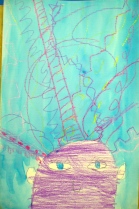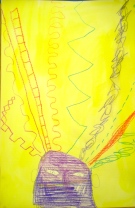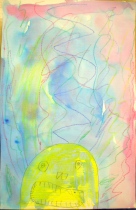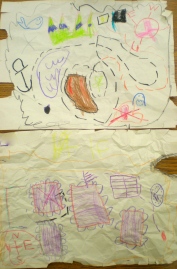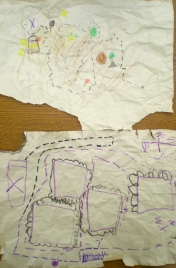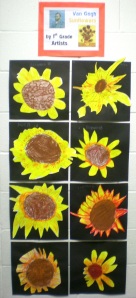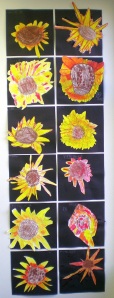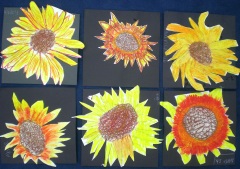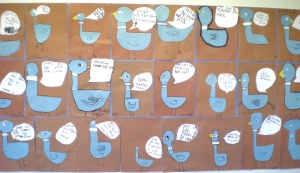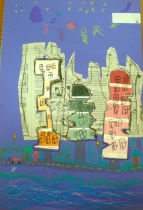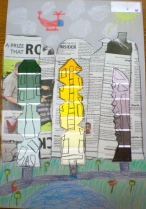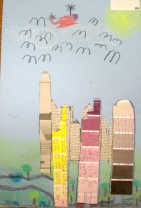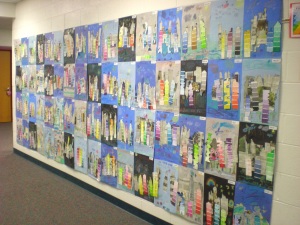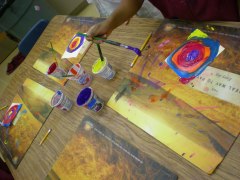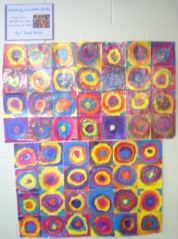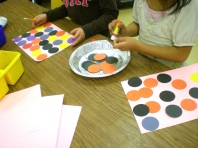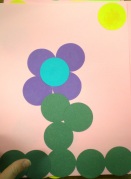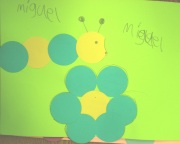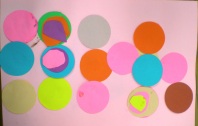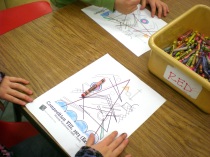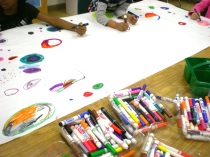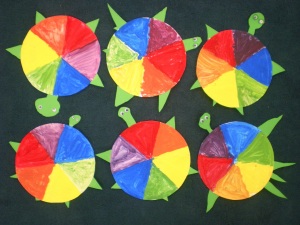Crazy Hair and Treasure Maps
Our first Kindergarten (I only have one section of them) and 1st grade project concentrated on noticing and creating different kinds of lines, one of the Elements of Design. We read the book Lines That Wiggle by Candace Whitman to inspire our creation of Crazy Hair Heads and make treasure maps using different kinds of lines. These turned out quite cute and opened up discussion about noticing some of the elements of design in the world around us like line, shape, color, value, form, texture, and space. To inspire our treasure maps we read Pirates Don’t Change Diapers by David Shannon. We also discussed using symbols as a form of communication, especially on maps and signs.
Our Learning Targets:
I can draw a variety of lines for my crazy hair.
I can draw a variety of lines for my treasure map.
Van Gogh Sunflowers
These sunflowers turned out absolutely gorgeous!! Each individual flower is beautiful, creative, and unique! When these were up in the hallway, it felt like walking into a serene sunflower garden. To introduce this project, we watched a short video Getting to Know Vincent van Gogh to learn a few facts about our artist. In this project we studied Vincent van Gogh’s Sunflower painting, identified and used warm colors, while familiarizing ourselves with the unique blending abilities of oil pastels. This lesson is definitely a keeper for years to come! 🙂
Our Learning Targets:
I can tell you what a still life is, show you how to draw a sunflower, and use warm colors.
I can use oil pastels and oil pastel techniques to create my sunflower.
Don’t Let the Pigeon
The Pigeon collage will always be one of my favorite lessons! Not only do we get to read the pigeon books by Mo Willems, like Don’t Let the Pigeon Drive the Bus, and Don’t Let the Pigeon Stay Up Late, we get to come up with our own silly sentences for what the Pigeon shouldn’t do! In this project we really concentrate on the idea that basic shapes can be placed together, like a puzzle, to make an animal. In further lessons, I expand this idea of using individual shapes to construct a whole image, whether it’s an animal, nature, object, or person. See my older posts about Mo Willem’s Pigeon if you want more information! 🙂
Our Learning Target:
I can use shapes to construct a pigeon with scissors, paper, and glue.
Paint Card Cities
This year I decided to put a new twist on my paint card cities!! We added and emphasized background buildings using newspaper shapes versus simply drawing them. I was so happy to stumble upon this idea a year ago, because I think the idea of using unconventional objects in a project helps students to begin to see new uses and ideas for everyday objects – leading to the concepts of reusing and recycling. A lot of art that is being produced now uses these everyday objects in new ways – CD’s, records, food, school supplies, kitchen utensils, etc. – showing a whole new side to thinking critically and problem solving.
Reading the book Iggy Peck Architect by Andrea Beaty allowed us to explore the profession of architecture, and led us to the conclusion that just as you can use shapes to construct animals (Pigeon Lesson), architects [and ourselves] can design and construct buildings out of shapes too. We carefully observed many pictures of cities to identify what buildings were in the background (far away, smaller, and less detail) and those that were in the middle ground/foreground (up closer, larger, brighter, and detailed). In addition to the concept of a background and foreground, we concentrated on the size and proportion of items you would see in a city (i.e. a person or tree would not be as tall as a sky scraper). Click here to see previous Paint Card City lessons.
Our Learning Targets:
I can use shapes to construct buildings like architects do.
I understand that buildings close to me are big.
I understand that buildings farther away are smaller, and might be partly covered by buildings that are closer to me.
Kandinsky Concentric Circles
Though International Dot Day had passed, creating the Kandinsky Concentric Circles is one of my favorite 1st grade projects to do (and it’s fun to hear them repeat the mouthful of a title J). We learn about Wassily Kandinsky, and his major influence for bringing attention to abstract art. I discuss with the kiddos that abstract art is not of something like a person, place, or thing but can simply be a work using colors, line, and shape. We go through a powerpoint showing thumbs up or down if the paintings and art displayed are abstract or not – because this is a higher concept, I stick to the idea that abstract means color, line, and shape. Emphasis is also placed on brush control in the concentric circle creation process, but also identifying circles and spheres in the world around us. In addition to reading The Dot by Peter Reynolds, we read Lots of Dots by Craig Frazier who discusses seeing dots in everyday life – “dots from trees” = oranges, “dots to eat” = ice cream/grapes/eggs, “dots that are big, dots that are small”, etc.
I do this project in centers in order to have a small group paint with me while other groups pursue dot and circle related activities. I am still in search of at least one or two other relevant and purposeful stations as I’ve tried a couple and feel I can create some that have more learning and creating involved, but am happy with the station inspired by Lots of Dots, and of course when we paint the concentric circles. The lots-of-dots station has the students manipulate lots of hole-punched one-inch dots, scissors, and glue and have the freedom to glue down and create something new with these dots.
See some of my older Kandinsky lessons here.
Our Learning Targets:
I can identify circles and dots in the world around me.
I understand that some art is abstract, only using colors, lines, and shapes.
I can paint concentric circles.
Painting Concentric Circles:
Creating with Lots of Dots:
Kandinsky Color Sheet and Dot Mural:
Turtle Color Wheels
I saw this idea on Art with Mr. E and thought it was so cute and brilliant! I LOVE teaching about the color wheel and color theory because we get to explore color mixing in new ways and knowing color is so important not only in the art field, but essential to many careers in our creative and global economy! My absolute favorite tool is this video by OK GO originally made for Sesame Street – I show it Kindergarten through 6th grade…it is catchy and done in Stop Motion Animation, so it’s funky to watch. We also read White Rabbit’s Color Book by Alan Baker, and manipulate a magnetic color wheel up on the white board. The real magic comes when the kiddos actually get to create the secondary colors (orange, green, and violet) using only the primary colors (red, yellow, and blue) I’ve given them. After the color wheels have dried, we add the green construction paper for the turtle parts, and the final touch of googly eyes!
Our Learning Targets:
I can identify the primary colors.
I can identify and mix the secondary colors.
I understand that mixing two primary colors will make a secondary color.
I can paint a correct color wheel.

